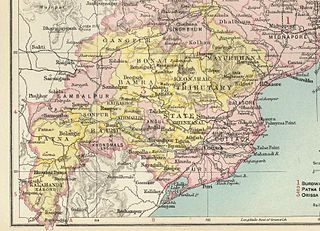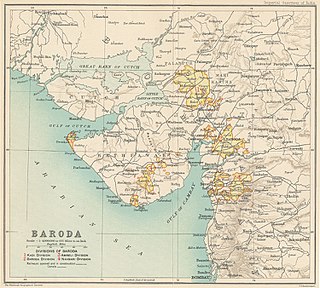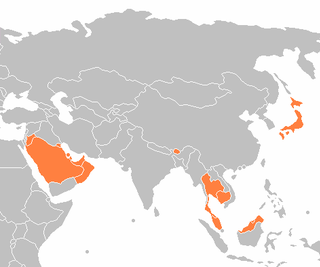
India is a federal union comprising 28 states and 8 union territories, for a total of 36 entities. The states and union territories are further subdivided into districts and smaller administrative divisions.
The doctrine of lapsation was a policy of annexation initiated by the East India Company in the Indian subcontinent for the princely states, and applied until the year 1858, the year after Company rule was succeeded by the British Raj under the British Crown.

Bombay State was a large Indian state created in 1950 from the erstwhile Bombay Presidency, with other regions being added to it in the succeeding years. Bombay Presidency was merged with the princely states of Baroda, Western India and Gujarat and the Deccan States.

A princely state was a nominally sovereign entity of the British Indian Empire that was not directly governed by the British, but rather by an Indian ruler under a form of indirect rule, subject to a subsidiary alliance and the suzerainty or paramountcy of the British crown.

Mysore State, colloquially Old Mysore, was a political territory within the Dominion of India and the subsequent Republic of India from 1947 until 1956. The state was formed by renaming the Kingdom of Mysore, and Bangalore replaced Mysore as the state's capital. When Parliament passed the States Reorganisation Act in 1956, Mysore State was considerably enlarged when it became a linguistically homogeneous Kannada-speaking state within the Republic of India by incorporating territories from Andhra, Bombay, Coorg, Hyderabad, and Madras States, as well as other petty fiefdoms. It was subsequently renamed Karnataka in 1973.

The Instrument of Accession was a legal document first introduced by the Government of India Act 1935 and used in 1947 to enable each of the rulers of the princely states under British paramountcy to join one of the new dominions of India or Pakistan created by the Partition of British India.
In India, a privy purse was a payment made to the ruling families of erstwhile princely states as part of their agreements to first integrate with India in 1947 after the independence of India, and later to merge their states in 1949, thereby ending their ruling rights.

Before India gained independence in 1947, India was divided into two sets of territories, one under direct British rule, and the other consisting of princely states under the suzerainty of the British Crown, with control over their internal affairs remaining in the hands of their hereditary rulers. The latter included 562 princely states which had different types of revenue-sharing arrangements with the British, often depending on their size, population and local conditions. In addition, there were several colonial enclaves controlled by France and Portugal. After independence, the political integration of these territories into an Indian Union was a declared objective of the Indian National Congress, and the Government of India pursued this over the next decade.

A salute state was a princely state under the British Raj that had been granted a gun salute by the British Crown ; i.e., the protocolary privilege for its ruler to be greeted—originally by Royal Navy ships, later also on land—with a number of cannon shots, in graduations of two salutes from three to 21, as recognition of the state's relative status. The gun-salute system of recognition was first instituted during the time of the East India Company in the late 18th century and was continued under direct Crown rule from 1858.

The Orissa Tributary States, also known as the Garhjats and as the Orissa Feudatory States, were a group of princely states of British India now part of the present-day Indian state of Odisha.

The Kathiawar Agency, on the Kathiawar peninsula in the western part of the Indian subcontinent, was a political unit of some 200 small princely states under the suzerainty of the Bombay Presidency of British India.

The Chamber of Princes was an institution established in 1920 by a royal proclamation of King-Emperor George V to provide a forum in which the rulers of the princely states of India could voice their needs and aspirations to the colonial government of British India. It survived until the end of the British Raj in 1947.

Dhar State was a princely state. It was a salute state in the colonial sway of the Central India Agency. Dhar began as one of the states during Maratha dominance in India about 1730. In 1941 it had an area of 1,798 square miles (4,660 km2) and a population of 253,210. Dhar was the capital of the state since 1732 (from the 1728 foundation, the Raja's first seat had been at Multhan in Dhar district. In 1948, it became part of Madhya Bharat.

There are several monarchies in Asia, while some states function as absolute monarchies where the king has complete authority over the state, others are constitutional monarchies where a monarch exercises authority in accordance with a constitution and is not alone in decision making.

The States Reorganisation Act, 1956 was a major reform of the boundaries of India's states and territories, organising them along linguistic lines.

Lunavada State, also known as Lunawada State, was a princely state in India during the time of the British Raj. Its last ruler acceded to the Union of India on 10 June 1948.
The Patwardhan princely state was established by the Patwardhan family, ruling several parts of the Maratha Empire from 1733 till 1948, when it acceded to the Dominion of India. At its peak, various branches of the dynasty controlled several Jagirs within the Maratha Empire, and later became protectorate Princely states in British India.













